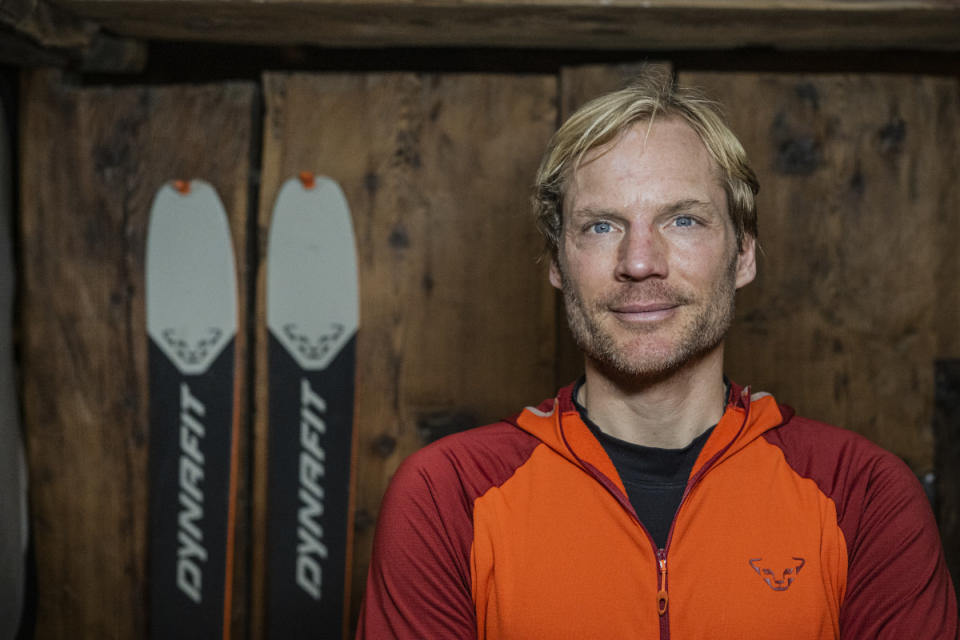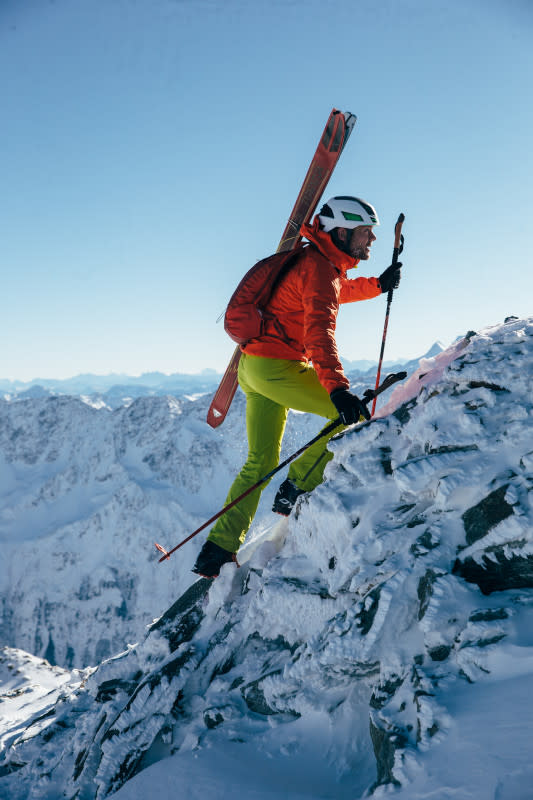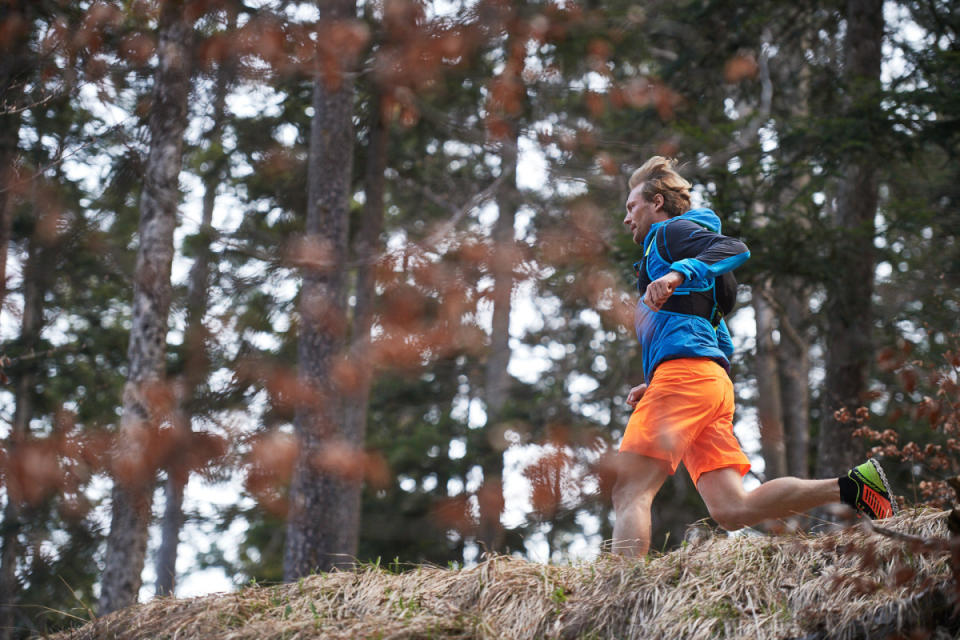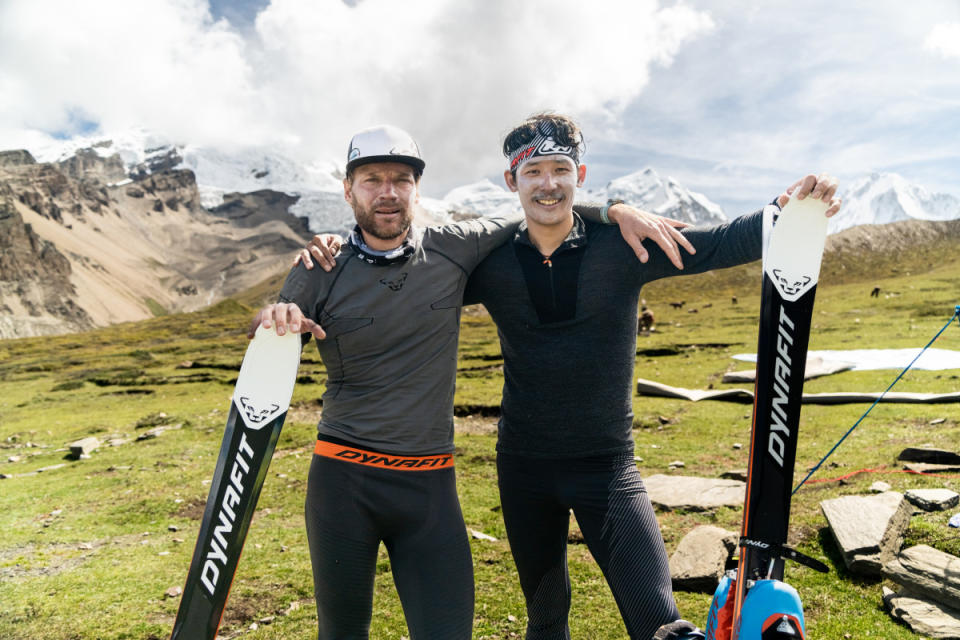Meet The CEO Who’s About To Attempt A World-Record Speed Skiing Climb On A Tibetan Peak
Powder will be offering coverage of Benedikt Boehm and Prakash Sherpa's attempt to climb and ski Cho Oyu, Tibet -- the 6th highest peak in the world -- in record time. Boehm and Sherpa depart on September 15th, so stay tuned for upcoming articles documenting their endeavors.
It was 2004, and Benedikt Boehm had botched one of his first experiments with speed mountaineering. He and two friends were in South America, hoping to rapidly climb several summits, including the 22,205-foot Nevado Huascarán in a then-unique style of skimo-infused alpinism.
But Boehm's hopes for success quickly collided with reality and a lack of preparation. While the team completed their planned ascents, they made several miscalculations that engendered misery, like not packing enough food and moving too quickly in high-altitude terrain.
The suffering concluded with a poetic coup de grace when Boehm and his buddies accidentally drank from a river with a dead cow in it. "We ended up in some hospital in Peru" where you "don't want to end up," Boehm says. He needed to return to the drawing board to realize his modern mountaineering vision.
Earlier this summer, Boehm and I connected on a video call to discuss his latest objective: Cho Oyu, a towering Tibetan peak. Since his misadventure in South America, he's honed his craft, developing an effective blueprint for ascending and descending mountains on skis at pace. Throughout the 2010s and early 2020s, Boehm and his rotating cast of climbing partners have notched several speed records on high-altitude peaks throughout the world -- without landing themselves in the hospital.

Courtesy: Dynafit
If, at this point, you assumed that Boehm is a Red Bull athlete who spends eight hours a day training in the gym for his next adventure, you'd be forgiven. His rap sheet in the mountains is immense, after all. However, perhaps inexplicably, climbing mountains is technically a hobby for Boehm, conducted before and after his not-so-inconspicuous day job: overseeing Dynafit, a world-renowned soft and hard goods company specializing in mountain endurance sports.
Picture a CEO like I did as I nervously awaited my 10 AM call with Boehm. What do they look like? How do they talk? What are their mannerisms? For most of us, cultural expectations have already answered these questions on our behalf: the CEO is tall, some combination of handsome and beautiful, charismatic, well-spoken, and serious.
Admittedly, Boehm is many, if not all, of these things. Although the beaming face that appeared on my screen still defied my expectations of the C-Suite. He projected warmth where I anticipated cold and frequently launched into excitable, playful digressions as our conversation followed his life and career.
Boehm explains that his energy, which seems to come through my laptop in waves, initially challenged him. He was born in Munich, Germany, alongside his three sisters and two brothers. As he grew, he quickly learned that structured environments, like school, didn't jive with his innate wiring. It was "a burden for me to have so much energy," he says.
Then, at age 11, Boehm found competitive cross-country skiing and realized that his disposition wasn't always problematic. "I suddenly found for the first time it's good, it's a good thing to have energy, you know, and because I learned to concentrate my energy towards these competitions," he says. Naturally, backcountry ski touring followed, which allowed Boehm to scratch his need for physical movement while spending time in the mountains.

Courtesy: Dynafit
Between 1956 and 2011, Germany had compulsory military service, meaning Boehm needed to spend time as a soldier after graduating high school. Fortuitously, he ended up in a mountain division, where ski mountaineer racing -- often called "skimo" -- was part of the deal. Boehm spent his first two months completing basic service, then participated in skimo races the following ten months. These races had a militaristic twist -- while he schlepped himself through the mountains, Boehm carried an assault rifle, which, at specific points, he used to fire at mannequins. Grenade tosses were also included. While Boehm ditched the ballistics after his service, the passion for skimo remained.
Skimo, for the uninitiated, is a quirky combination of alpine racing, Nordic, and backcountry skiing, wherein athletes don skin-tight clothing and other ultra-light gear as they endeavor to ski up and down mountains as fast as possible alongside other competitors. It's a niche sport, requiring borderline neurotic attention to detail because when you're trying to beat the next guy or gal up the skin track, every kilogram counts. Speed, particularly on the uphill, is the obsessive, throbbing heart of skimo.
Boehm, via his speed record attempts, would eventually infuse the key elements of skimo -- rapid alpine traversal, training for race-level fitness, the use of skis for the uphill and downhill, and lightweight gear -- with alpinism, a modern strain of mountaineering wherein "fast and light" was already the guiding principle. Traditional mountaineering, in contrast, employs "siege tactics" that involve larger groups supported by porters or sherpas, multiple overnights on the mountain, and enormous quantities of gear.
"You know, that [traditional mountaineering] was a little bit of a different generation," Boehm says. "We had that race background, that competition background, and for us, it was more about, yeah, I would say perfecting or trying to perfect speed."
As Boehm transitioned into the workforce after college, he believed that his work needed to follow his love for the mountains and skimo, so he applied for a job at Dynafit in 2003, which, at the time, was a small, ailing ski hardgoods company. When Boehm arrived to work as a sales rep, Dyanfit was nearly bankrupt despite introducing the innovative ultra-light Tour Lite Tech binding to backcountry skiers over ten years earlier via a partnership with inventor Fritz Barthel. The Tour Lite Tech setup, or TLT, was the world's first mass-market pin binding setup.
"That [the TLT binding] was the biggest asset of Dynafit at the time, but everybody misunderstood it," Boehm says. The objective for Boehm in his new position was to translate his enthusiasm for mountain endurance sports into a successful brand by communicating the potential of Dynafit's products to a broader audience.
In the early 2000s, backcountry skiing, and its niche, speed-focused cousin, skimo, weren't booming industries (skimo will become an Olympic sport for the first time in 2026). During our conversation, Boehm estimated that when he started at Dynafit, the brand was operating in a market only valued at 30 million euros. Large-scale industries, like agribusiness, are valued at billions, if not trillions, of dollars across various markets. Dynafit was a small fish in a small pond.
In addition to Boehm's arrival as a sales rep, 2003 saw the purchase of Dynafit by the Oberalp Group. Under the fresh ownership of this conglomerate, Dynafit slowly began establishing itself as a brand "by athletes for athletes." Boehm hired friends from within the skimo community and worked to get Dynafit's lightweight bindings to those who would appreciate them. Percentage point by percentage point, these efforts paid off as Dynafit "evolved from a 2 million euro brand towards a 100 million euro brand," says Boehm.
For his first few years with the company, Boehm competed in skimo as a member of the German National Team but eventually had to quit as his work responsibilities expanded. Still, he continued to pursue alpine speed records alongside his duties as Dynafit's eventual CEO, starting with his ill-fated trip to South America in 2004.
Like most people, I work a reasonable amount -- roughly 40 hours a week -- and often struggle to make time for fitness. In contrast, as a CEO, Boehm works far more than 40 hours a week while training at an elite level near-daily. Plus, he has a wife and three kids. You and I are probably on the same page here in wondering: how does he do it? Of course, I asked.

Courtesy: Dynafit
The nuts and bolts of his work-life balance are uncomplicated. He typically rises around 3 AM to clock a backcountry ski, run, or bike before starting work at 9 AM. After finishing work in the evening, he spends time with his family before catching 5 or 6 hours of sleep. Then, he does it again. Boehm estimates that he climbs between 33,000 and 16,000 feet a week, depending on the season. "I have to admit that I have much more motivation in winter because my life is skiing, you know. I'm a skier," he says.
The motivation factor of Boehm's life isn't particularly nebulous, either, perhaps best summed up by the following phrase he spoke during our conversation, "I live every day as race." It's an easy decision, he explains without a hint of disdain towards those who prefer the opposite, to choose early mornings over late nights spent watching Netflix. This intentionality allows him to balance every facet of his unquestionably intense existence and pursue endeavors reserved for elite athletes, like his upcoming trip to Cho Oyu. If anything, Boehm embodies the high-speed mountain endurance ethos of the brand he leads.
On Cho Oyu, the Nepalese Prakash Sherpa, a Dynafit team athlete and internationally certified mountain guide, will join Boehm. Sherpa and Boehm have established rapport -- in 2022, the duo successfully set a new speed record on Himlung Himal, a 23,379-foot peak in Nepal.
As with their previous outing, Boehm and Sherpa plan to ascend and descend Cho Oyu in record time. While tremendously high, the peak is considered intermediate by mountaineering standards due to its lack of technical climbing. However, Boehm and Sherpa's chosen speed-focused style considerably ups the ante. Usually, ascending Cho Oyu takes multiple days. If everything goes according to plan, Boehm and Sherpa will be up and down in 14 hours, which, Boehm admits, might be "a little too ambitious."
Neither Boehm nor Sherpa will use supplemental oxygen, reducing the time they can safely spend on Cho Oyu's 26,864-foot peak. Parts of a mountain above 26,000 are known by peak baggers as the "death zone," wherein the lack of ambient oxygen can result in a loss of bodily functions, unconsciousness, and, in some cases, death.

Courtesy: Dynafit/Mountain Film Crew
The decision to forgo supplemental oxygen stems from Boehm's adherence to "fair means" ascents -- in alpinism and mountaineering, "fair means" is defined as reaching a summit exclusively under your own power.
Logistics-wise, the trip begins in Kathmandu, Nepal, where the team will spend a few days claiming visas. Afterward, they'll travel to Tibet by land because air travel from Europe isn't permitted. Once at Cho Oyu, Boehm and Sherpa will have roughly three weeks to acclimatize -- getting the human body used to high altitudes is necessary before climbing a peak like Cho Oyu -- and secure the planned route with gear like fixed lines because Boehm believes that there hasn't been a climbing team on Cho Oyu in roughly four years.
While blitzing Cho Oyu is a feat, the team must also tangle with Tibet's de facto ruler: China. In 1951, China annexed Tibet and now controls the country as an autonomous zone. Boehm and Sherpa will pass through multiple security checkpoints on their trip and navigate bureaucratic restrictions linked to their visas.
The question of a Cho Oyu speed record will unfold starting on September 15th, so stay tuned to Powder for more updates from the field.
Don't miss another headline from POWDER! Subscribe to our newsletter and stay connected with the latest happenings in the world of skiing.
We're always on the lookout for amusing, interesting, and engaging ski-related videos to feature on our channels. Whether you're a professional skier or just an amateur, we want to see your best footage and help you share it with the world. Submit your video for a chance to be featured on POWDER and our social channels. Be sure to subscribe to our YouTube channel to watch high-quality ski videos.

